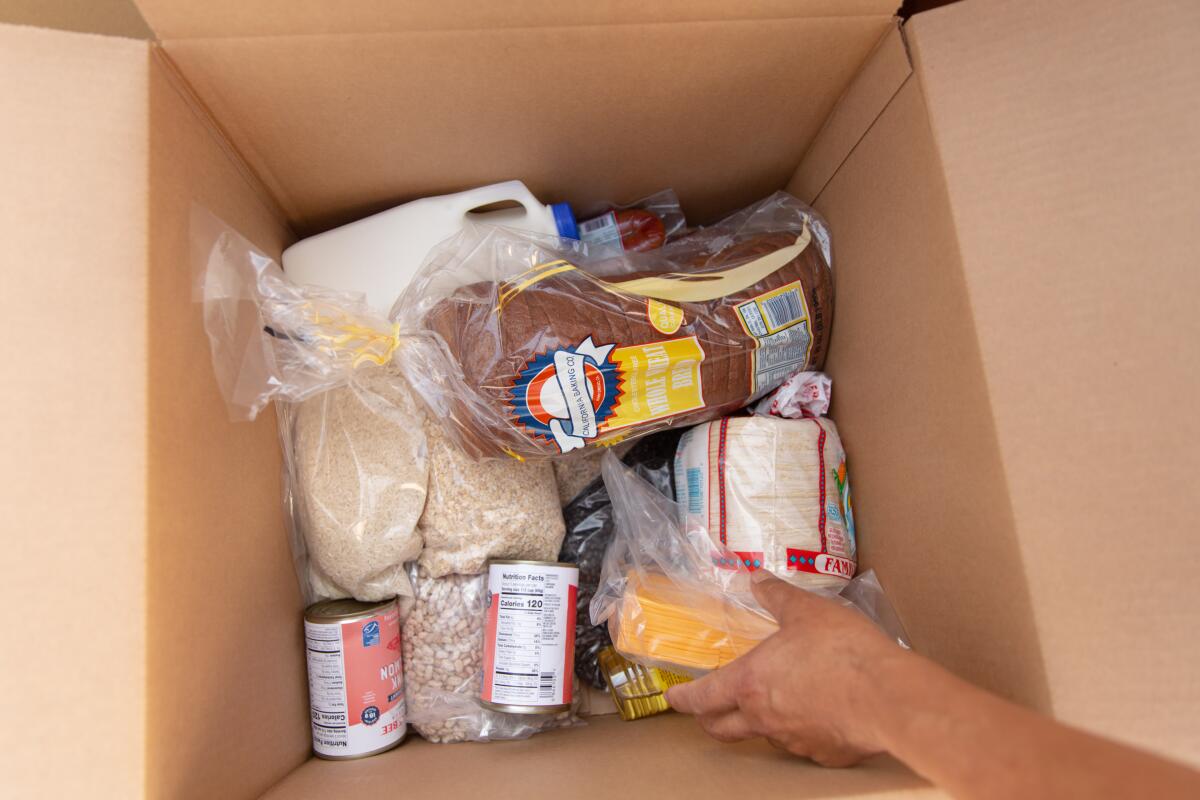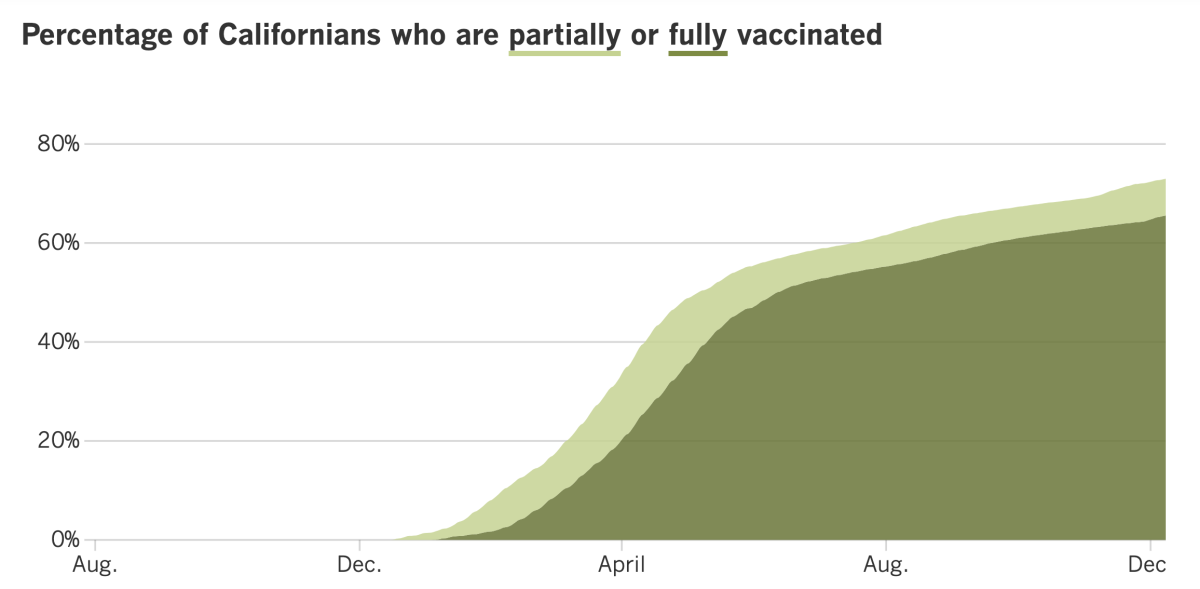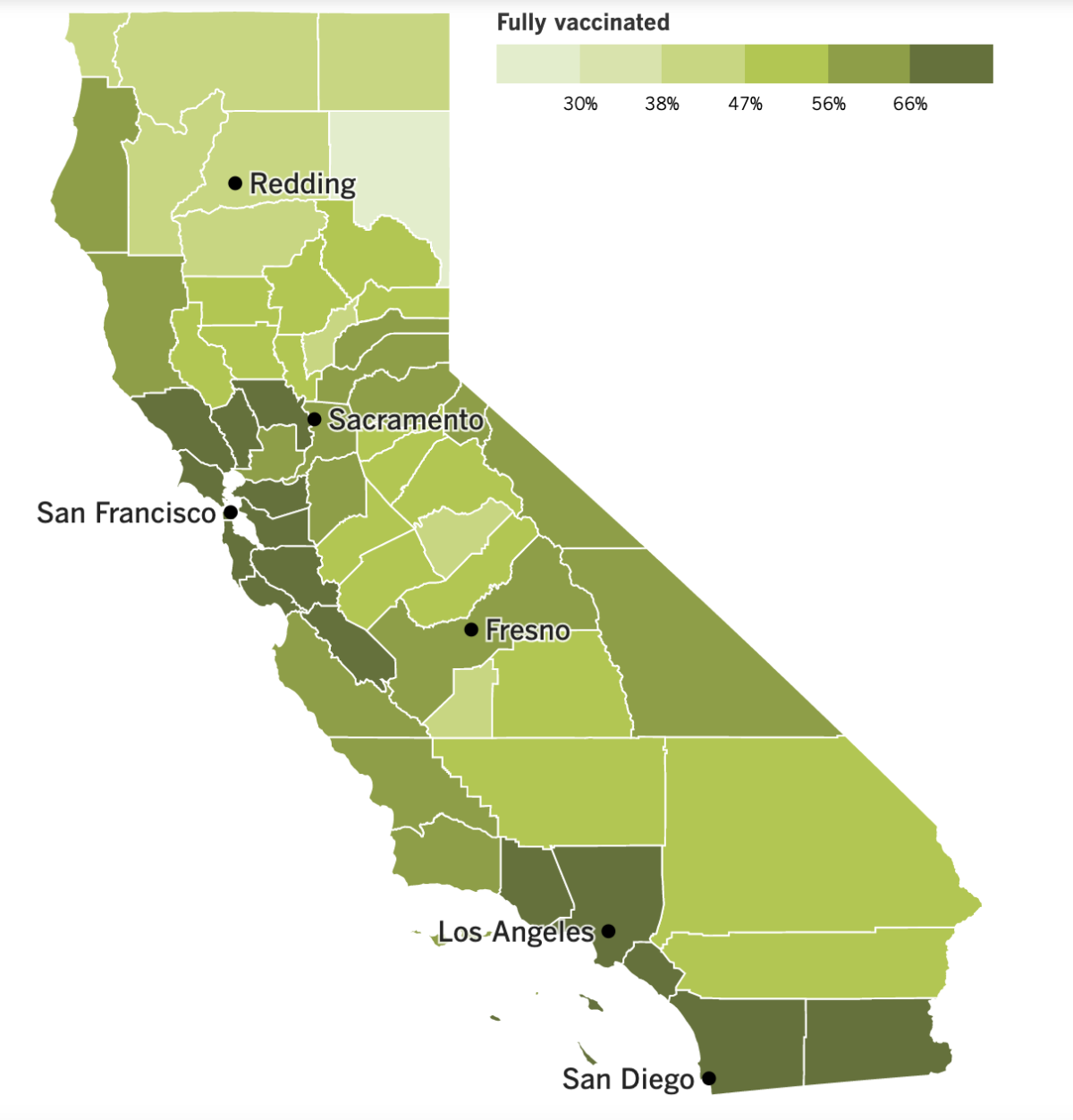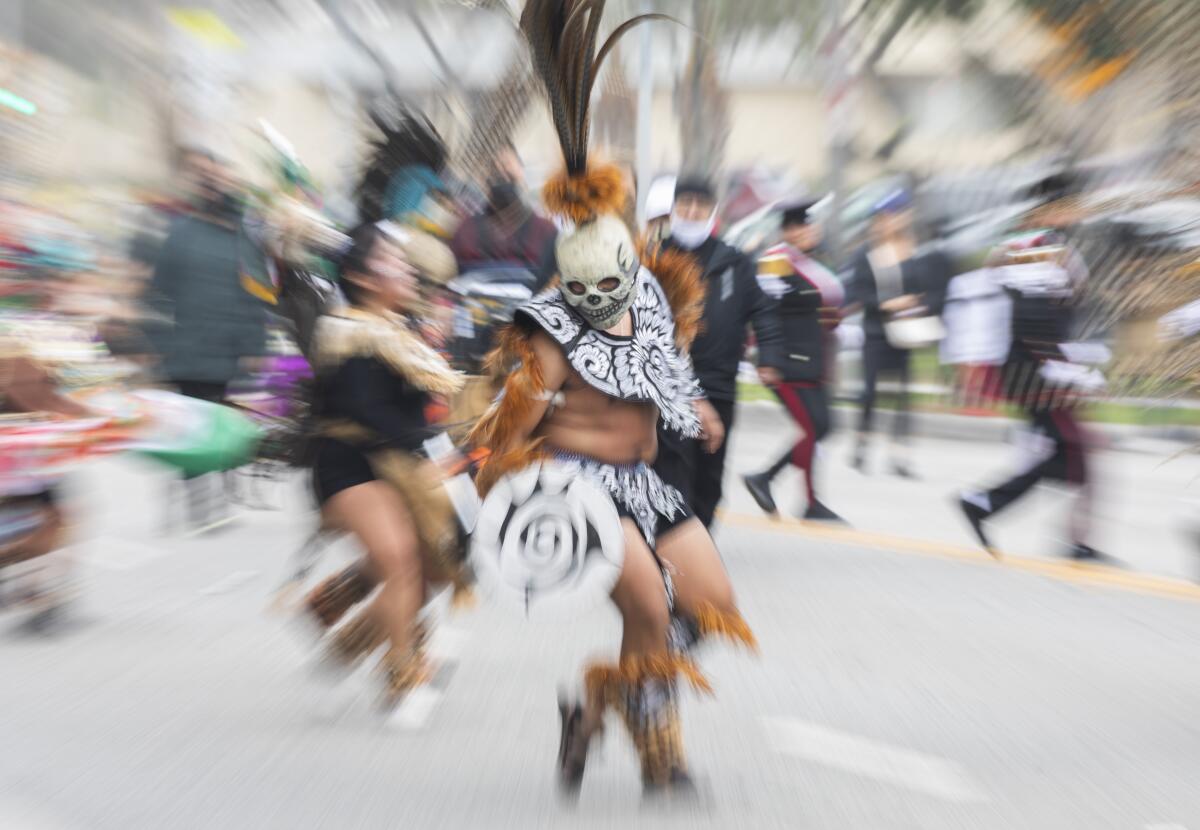Coronavirus Today: Another way the pandemic kills
Good evening. I’m Karen Kaplan, and it’s Friday, Dec. 10. Here’s the latest on what’s happening with the coronavirus in California and beyond.
Over the past 20 months, while the country’s attention has been focused on the nearly 800,000 Americans who have died of COVID-19, tens of thousands of other deaths have largely escaped our notice.
Among them is Monique Muñoz, whose car was nearly split in half by a teenage driver going more than 100 mph through a Los Angeles intersection. And Yolanda Bozonier, who died in her bed when a drunk driver slammed into her Pomona house. And Sheria Musyoka, a San Francisco jogger who was killed in an eight-car pile-up triggered by an intoxicated driver in a stolen vehicle.
Altogether, 38,680 people died in car accidents last year. That was the highest tally since 2007, my colleagues Emily Baumgaertner and Russ Mitchell report. Experts speculated the increase was a sign that people were unleashing their pandemic anxieties on wide-open roads, and they predicted that things would go back to normal in 2021.
Instead, traffic fatalities increased another 18% in the first six months of the year.
Now experts are worried the coronavirus has made U.S. drivers more likely to speed, more likely to drive under the influence, more likely to drive without wearing seatbelts, and more likely to be reckless in general.
“I fear we’ve adopted some really unsafe driving habits, and they’re going to persist,” said Ken Kolosh, a researcher at the nonprofit National Safety Council. “Our roads are less safe than they were pre-pandemic.”
The carelessness seen on the roads is likely a manifestation of our collective sense of isolation, loneliness and depression, said Shannon Frattaroli, a researcher at Johns Hopkins Bloomberg School of Public Health.
“We might decide: What does a seatbelt or another beer matter, anyway, when we’re in the middle of a pandemic?” she said.

The sudden spike in traffic fatalities is even more striking when you consider that lockdowns, working from home and distance learning caused Americans to drive less. In 2020, there were 1.37 deaths per 100 million miles driven — a 23% increase from 2019.
Traffic deaths rose almost everywhere — on highways and backroads, in cities and rural areas, during the day and at night, on weekdays and weekends. They were up in all but nine states — Alaska, Delaware, Hawaii, Idaho, Maine, Nebraska, New Mexico, North Dakota and Wyoming — and in every age group 16 to 65.
As usual with the pandemic, people who were already disadvantaged took a bigger hit: The traffic-related death rate for Black people rose more than three times faster than for the nation as a whole.
That may be partly explained by the fact that Black people make up a disproportionate share of the essential workforce, including delivery drivers who are “paid by how fast you can move,” Frattaroli said. It may also reflect a deeper sense of despair in a community to which the coronavirus was particularly unkind.
It’s not hard to fathom how COVID-19 may have taken Americans’ road rage to a new level. But Jonathan Adkins, executive director of the nonprofit Governors Highway Safety Assn., made a particularly troubling observation. He raised the possibility that the disregard shown by drivers for themselves and others was an extension of a national decline in civility that was exacerbated by the pandemic.
“Anecdotally, we hear from governors’ offices around the country that it’s a symptom and a sign of the overall lack of consideration we’re showing for other citizens, whether it be wearing masks, or not getting vaccinated, or how we drive,” he said. “It’s very aggressive. It’s very selfish.”
By the numbers
California cases and deaths as of 3 p.m. Friday:

Track California’s coronavirus spread and vaccination efforts — including the latest numbers and how they break down — with our graphics.
Looking out for those who put food on our tables
If the rise in fatal car crashes is an example of the pandemic leaving us too drained to look out for one another’s well-being, this story is the opposite. It’s about a community organization that was already helping some of the most vulnerable people in Los Angeles, then expanded its services to meet needs brought on by the pandemic.
The hero of this story is CIELO, or Comunidades Indígenas en Liderazgo. CIELO advocates for Indigenous people, including a good portion of the undocumented workers in L.A.-area restaurants. Although they may present as Latinx, they’re not necessarily fluent in Spanish; many speak only the Indigenous languages of their home villages in Mexico or Central America.
Before the pandemic, CIELO spent most of its time dispatching interpreters to places like hospitals, police stations and courthouses to help migrants get services they needed.
Now its 13 staffers offer COVID-19 vaccines at weekly clinics, provide personal protective equipment to essential workers, and share educational videos that explain safe COVID-19 practices in Indigenous languages, food writer Esther Tseng explains.
That’s just the beginning.
CIELO also offers cash payments of $500 to help pay rent and other expenses — a lifesaver for those who lost work when the pandemic forced employers to scale back or shut down. More than $2.2 million in grants have been distributed to date, along with $1.8 million worth of grocery gift cards. Boxes containing pantry staples including rice, beans, tortillas and milk are also handed out on a weekly basis.

And then there’s the time CIELO spends helping Indigenous people apply for government services — a task that can be daunting even for native English speakers.
“I helped someone the other day register for the utilities forgiveness program in L.A. County on the computer,” said Odilia Romero, CIELO’s executive director and co-founder. “It took us an hour and a half, and then the system crashed.”
All these efforts were prompted by a request for help from a restaurant worker who came to CIELO in the early days of the outbreak, said Romero’s daughter Janet Martinez, who serves as director of programs for the organization.
Many restaurants have established a new normal, with smaller dining rooms and more elaborate take-out operations. They’ve stabilized but with fewer hours to offer their employees. “Others closed because they were unable to sustain themselves,” Romero said. “So [laid-off workers] have accrued debts from rent, car payments and more over a whole year from losing their jobs and not having income for months.”
That was the case for Gustavo Molina, a longtime cook in the Beverly Hills area who was let go in March 2020.
“Initially, the other cooks and I thought it was going to last one to two weeks — or one month, at the most,” he said. “But later, we found out that the restaurant was going to close completely.”
Molina, who is Zapotec, turned to part-time work as a gardener and now works at a different restaurant, though for fewer hours than he worked before the pandemic.
Molina turned to CIELO after he lost $1,800 to fraudsters who passed themselves off as police officers and threatened to “charge” him with a crime if he didn’t pay up.
“Odilia connected me with the captain of the Rampart police station, and I told him the whole story,” Molina said. “He told me that it was a scam and helped me file a report.”
People like Molina are lucky to have an organization like CIELO in their corner. And as far as Romero is concerned, we’re all lucky to have people like Molina working on our behalf.
“The Indigenous peoples have always been putting food on our table,” Romero said.
Tseng’s article on CIELO is part of a package of stories by The Times Food section highlighting L.A.’s 101 best restaurants. The package includes pop-up dining spots and places to grab a drink. Check it out if you’d like to see if your favorites made the list.
California’s vaccination progress


See the latest on California’s vaccination progress with our tracker.
Your support helps us deliver the news that matters most.
In other news ...
The winter surge that public health officials have feared may be upon us.
In Los Angeles County, weekly case rates are up 33% in the past two weeks, putting the nation’s most populous county back into the red category of “high” community transmission, according to the Centers for Disease Control and Prevention. In fact, with the exception of Orange County, all Southern California counties are in the red as of Friday, the CDC’s COVID Data Tracker shows.
In L.A. County, the number of patients hospitalized with COVID-19 is up 21% since Nov. 22, three days before Thanksgiving. And coronavirus cases detected among schoolchildren have risen to their highest level since late September, said L.A. County Public Health Director Barbara Ferrer.
“Based on the trends, we are looking at the possible beginnings of a winter surge,” Ferrer said, adding that Thanksgiving gatherings likely seeded the new spread.
She’s not the only one who thinks so. Rigoberto Vargas, Ventura County’s director of public health, said the recent uptick in cases in that county was suggestive of a Thanksgiving weekend boost in transmission. And Dr. Sara Cody, the Santa Clara County health officer and director of public health, said she was keeping a close eye on the rising numbers there.
“We may be entering our fifth wave,” she warned the county Board of Supervisors.
Statewide, new infections are up more than 30% since before Thanksgiving, with hospitalizations climbing as well after weeks of mostly steady declines.
And across the country, new cases are up from an average of nearly 95,000 a day on Nov. 22 to more than 118,000 a day by midweek, CDC data show. Average daily deaths have been above 1,000 every day for more than a week now, and if present trends continue, the U.S. will record its 800,000th COVID-19 death sometime next week, according to the Johns Hopkins University tracker.
Officials are pushing COVID-19 vaccines and boosters to stem the tide. L.A. Unified enforced its vaccine mandate for employees this week by firing nearly 500 people who failed to get their shots or be exempted from the requirement.
That’s a big number, but it’s much smaller than officials previously feared. It represents fewer than 1% of the school district’s workforce, and only seven of the dismissed employees held teaching credentials.
“Parting ways with individuals who choose not to be vaccinated is an extremely difficult but necessary decision to ensure the safety of all in our school communities,” said interim Supt. Megan K. Reilly.
Reilly showed more leniency to the roughly 34,000 students ages 12 and up who were on track to miss the district’s Jan. 10 deadline to be fully vaccinated if they wanted to keep attending school in person. Reilly indicated Friday that enforcement of the deadline would be delayed until the start of the next school year.
More than 86% of LAUSD students who are subject to the mandate have been immunized, including thousands who were likely spurred to do so because of the district policy. That’s the good news. But the bad news is the district isn’t prepared to accommodate tens of thousands of additional unvaccinated students through its City of Angels independent study program, which is already struggling to keep up with demand.
In other vaccine news, the CDC said fully vaccinated 16- and 17-year-olds should get a booster dose of the Pfizer-BioNTech shot six months after their second dose. The endorsement came Thursday, hours after the Food and Drug Administration authorized the shots for these older teens.
If they need some encouragement, they could look to a study published Wednesday in the New England Journal of Medicine. The new research showed Israel’s aggressive use of Pfizer’s booster shots reduced infections and saved lives in people of all ages.
The third doses prevented new infections most dramatically in Israelis ages 16 to 29. They also drove down cases of severe COVID-19 and death in those 60 and older. Among all age groups, those who got a booster were at least 10 times less likely than their unboosted peers to test positive for a coronavirus infection, according to the study, which drew from a national database of nearly 4.7 million Israelis.
Pfizer and BioNTech said this week that people who received three doses of its vaccine — the two initial jabs plus a booster — appeared to have enough coronavirus-fighting antibodies to fend off infections caused by the Omicron variant. The companies acknowledged that two doses alone might not provide sufficient protection.
Pfizer, BioNTech and other vaccine makers are already working to reformulate their shots so they can better target the Omicron variant. The changes may turn out to be unnecessary, but they want to be ready just in case. If nothing else, it’s a useful drill to see how quickly they can adjust their recipes, churn out new vials, and demonstrate to regulators that they’re safe and effective.
Omicron “is pulling the fire alarm,” said E. John Wherry, an immunologist at the University of Pennsylvania. “Whether it turns out to be a false alarm, it would be really good to know if we can actually do this.”
There may be little time to waste. Although the Delta variant still accounts for 99.9% of coronavirus infections in the U.S., Omicron continues to make its presence known. More than a dozen infections have been confirmed in California, including five in L.A. County. The fifth patient was fully vaccinated and had received a booster shot, L.A. County health officials said. The patient’s symptoms were mild.
This patient stands out because officials believe he or she contracted the virus locally instead of while traveling overseas. What’s more, multiple close contacts of the patient subsequently tested positive for coronavirus infections. It’s not yet clear which variant sickened them.
San Diego, Santa Clara, Alameda, San Francisco and Yolo counties have also reported Omicron cases.
There’s also evidence that someone in Merced County was infected with the Omicron variant on Thanksgiving Day, if not sooner. A wastewater sample collected there on Nov. 25 contained a mutation seen in Omicron, according to the California Department of Public Health.
It’s another sign that Omicron was on the move well before scientists were aware of its existence.
Your questions answered
Today’s question comes from readers who want to know: How will the world decide when the COVID-19 pandemic is over?
Wouldn’t it be great if there were a clear-cut definition of when a pandemic ends? Then we’d have a clear-cut goal to shoot for.
Unfortunately, it doesn’t work that way.
“It’s somewhat a subjective judgment because it’s not just about the number of cases,” explained Dr. Michael Ryan, executive director of the World Health Organization’s Health Emergencies Program. “It’s about severity and it’s about impact.”
No one thinks COVID-19 or the coronavirus that causes it will ever go away. But we live with plenty of infectious diseases, and it’s rare for one to spark a pandemic.
The key question is whether the disease is causing a health emergency that is global in nature. (You may recall that it was only after the coronavirus had spread to nearly every continent that the COVID-19 outbreak was upgraded from a “public health emergency of international concern” to a full-blown pandemic.)
It’s possible that — with vaccines, testing and treatments — some countries may be able to get their coronavirus situations under control while other countries are still struggling. But since a new variant can turn up anywhere and quickly spread around the globe, it’s not clear what it would take for authorities to consider a region out of the woods — especially since it may take just a mutation or two for a new strain to severely undermine existing vaccines or medicines.
The WHO has a committee of experts that meets every three months to assess whether COVID-19 continues to present an international health emergency. When they agree that it doesn’t, the world will probably consider the pandemic over.
We want to hear from you. Email us your coronavirus questions, and we’ll do our best to answer them. Wondering if your question’s already been answered? Check out our archive here.
The pandemic in pictures

We can measure our progress in the pandemic by looking for signs that life has returned to its pre-coronavirus ways. One of those came Sunday, in the form of the Virgen de Guadalupe procession in East Los Angeles.
The annual celebration went on hiatus last year, replaced with a public-health-minded car rally complete with a Mass in the parking lot of the San Gabriel Mission.
Sunday’s more traditional procession included 20 floats. That’s about half as many as in pre-pandemic 2019; after all, the community is still apprehensive about COVID-19, my colleague Andrew J. Campa reported.
But for many of those in attendance, the atmosphere felt like a homecoming.
“It’s a great blessing to be back and in person,” said Archbishop José Gomez. “Last year we couldn’t have it because of the pandemic, so the community presence is a great joy.”
Resources
Need a vaccine? Here’s where to go: City of Los Angeles | Los Angeles County | Kern County | Orange County | Riverside County | San Bernardino County | San Diego County | San Luis Obispo County | Santa Barbara County | Ventura County
Practice social distancing using these tips, and wear a mask or two.
Watch for symptoms such as fever, cough, shortness of breath, chills, shaking with chills, muscle pain, headache, sore throat and loss of taste or smell. Here’s what to look for and when.
Need to get a test? Testing in California is free, and you can find a site online or call (833) 422-4255.
Americans are hurting in many ways. We have advice for helping kids cope, resources for people experiencing domestic abuse and a newsletter to help you make ends meet.
We’ve answered hundreds of readers’ questions. Explore them in our archive here.
For our most up-to-date coverage, visit our homepage and our Health section, get our breaking news alerts, and follow us on Twitter and Instagram.




